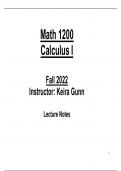Class notes
Calculus for scientists 1 teacher notes package
- Course
- Institution
- Book
This is the notes package used by the professor keira gunn at mount royal university in calgary. The package follows the “ third edition calculus early transcendentals” textbook 1-4 and great to look at for theory understanding and problems.
[Show more]




